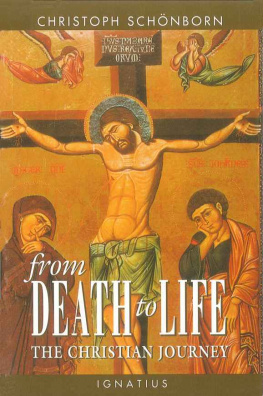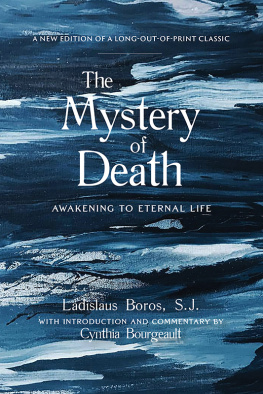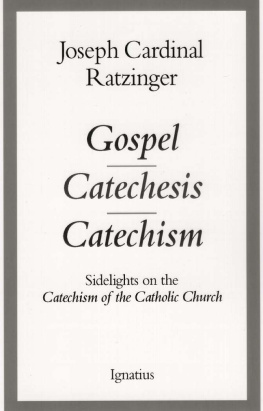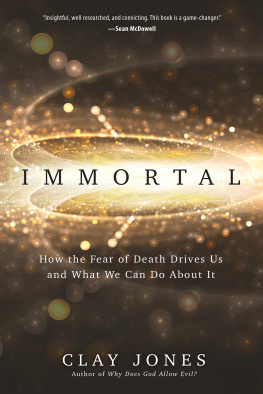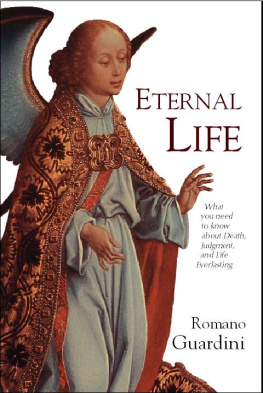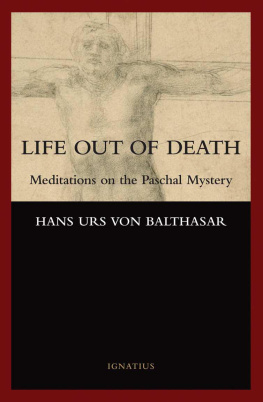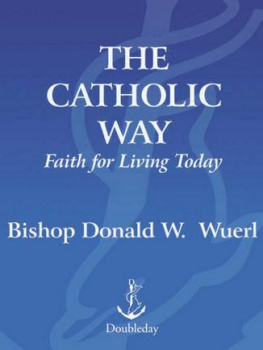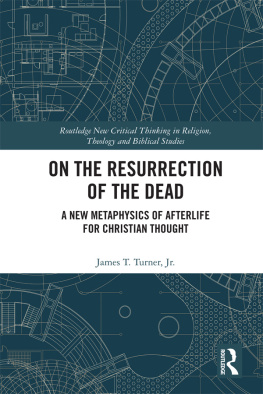FROM DEATH TO LIFE
CHRISTOPH SCHNBORN, O.P.
FROM DEATH
TO LIFE
The Christian Journey
Translated by
Brian McNeil, C.RV.
IGNATIUS PRESS SAN FRANCISCO
Title of the German original:
Existenz im Ubergang:
Pilgerschaft, Reinkarnation, Vergottlichung
Einsiedeln, Trier: Johannes Verlag, 1988
Cover art: Sinai, Icon with Crucifixion
Photo 1978, AlexandriaMichiganPrinceton Expedition
to Mount Sinai
Reprinted by permission of George Braziller, Inc.
from The Icon by Kurt Weitzman
Cover design by Riz Boncan Marsella
1995 Ignatius Press, San Francisco
All rights reserved
ISBN 0-89870-535-5 (PB)
ISBN 978-1-68149-718-1 (EB)
Library of Congress catalogue number 94-79299
Printed in the United States of America
To
Dorothee Welp
in gratitude
CONTENTS
1. Witnesses of the Rule of Faith
2. The Article of Faith in Controversy
3. The Mystery of His Present Lordship
1. The Christian Meaning of Deification
a. Christ as the Humanized God and Deified Man
b. In What Does Deification Consist?
c. Redemption and Deification in Christ
d. Deification of Man through the Sacraments of the Church
2. Mans Self-Deification and Self-Destruction
3. Humanization through Deification
1. One Single Church of Heaven and Earth
a. The Unity of the Pilgrim Church and the Heavenly Church
b. The Church Is Essentially Heavenly
2. Disputed Questions
a. The Church and the Kingdom of God
b. Is the Eschatalogical Character of the Pilgrim Church (LG 48) the Eschatalogical Character of the Kingdom of God?
c. The Fata Morgana of Eschatology
3. Theological and Pastoral Tasks in View of a More Complete Reception of Lumen Gentium
a. Christocentric Eschatology
b. Ecclesia de Angelis
c. Maria-Ecclesia
1. Jean-Jacques Rousseaus Thesis of the Socially Damaging Character of Christianity
2. No One Can Serve Two Masters (Mt 6:24)
3. The Kingdom of God, Society, and the Problem of Evil
1. What Position Did Early Christianity Take on Reincarnation?
a. Gnosis and Reincarnation
b. Christian Anthropology in Contrast to Reincarnation
Irenaeus of Lyons: A Biblical Anthropology Gains Acceptance
Origen: A Christian Who Teaches Reincarnation?
2. Reincarnation Today: The Answer of Faith
a. Every Fourth European Believes in Reincarnation
b. But Christ Is the End (Holderlin)
1. The Liturgy of the Transition ( Transitus )
2. Ars Moriendi as an Aid to Living
a. Dying as a Human Celebration
b. Dangers of the Transition
c. Transition as Judgment
d. Life in Transition
FOREWORD
But our homeland is in heaven, whence we also await the Savior, our Lord Jesus Christ (Phil 3:20). Is the yearning for a life beyond death the fundamental mood of the earliest Churchthe expectation of the end of the world on the part of a little flock of the chosen ones, in flight from the world, which is too narrow and too hostile to them, so that they cannot find any undisturbed joy in it?
The charge that Christianity is a contempt for the earth that transposes consolation into a life beyond death runs like a red thread through the history of anti-Christian polemics, from Celsus to Nietzsche. And it is a fact that Christian proclamation has been filled from early days with the yearning for heavenly fulfillment: Seek the things that are above, where Christ is, seated at the right hand of God. Strive to attain what is above, not what is on earth (Col 3:1-2). Let us quote Augustine as a representative of the countless preachers who have lived and proclaimed this existence in transition: Thus, we are still on the way. Wherever we may come, we must still pass on further [ transire ], until we reach the goal. We know that we shall be like him, when he appears; for we shall see him as he is (1 Jn 3:2). That is the goal. There, there is eternal praise, there an eternal, unceasing alleluia. There are two lives, one here , the other there . We live correctly here only to the extent that we do not lose sight, in all the now (nunc ), of the then (tunc ). Augustine speaks again and again of these two lives ( duae vitae ):
una in fide, altera in specie ;
una in tempore peregrinationis, altera in aeternitate mansionis ;
una in labore, altera in requie ;
una in via, altera in patria ;
una in opere actionis, altera in mercede contemplationis .
(We live the one life in faith, / the other in vision; // the one in the time of pilgrimage, / the other in the eternity of abiding; // the one in toil, / the other in rest; // the one en route , / the other in our native land; // the one in the work of activity, / the other in the reward of contemplation.)
We ought to be cautious about dismissing this attitude toward life all too quickly as contempt for the world. All this does indeed sound like a flight from the world, yet these men did not despise creation, and while they spoke of this world as a valley of tears, they were at the same time aware of its beauty; they cultivated it, built cathedrals, and created works that continue to nourish us even today.
How could a man with such zest for living, so famous for his humor, such a lover of music as Saint Philip Neri (the inventor of the Oratory) write the following sonnet?
Qual prigion la ritien chindi partire
non possa, e al fin coi piei calcar le stelle
e viver sempr in dio e a se morire?
(What prison holds the soul back so that it cannot depart from hence, so that it finally can trample the stars under its feet and live forever in God and die to itself?)
This is where the Marxist critique of religion makes its attack: religion distracts men from earthly distress; eschatological hope makes them incapable of resistance and submissive.
Today, language about mans pilgrim path, about his homeland in heaven, of earthly tribulation and hope for life beyond death, has become largely a foreign language in the Christian churches. It is only seldom that a sermon dares to look out on the vista of eternal life. It seems that fear of being accused of dispensing a consolation in a life after death and of fleeing from the world has become to a large extent a self-censorship (for the most part, no doubt, something of which the speaker is not aware). The silence about the heavenly dimension of our faith, of course, has consequences. Is not this eschatological amnesia of our preaching one reason why many people no longer turn to the Church when they want information about the last things? The growing interest in spiritualist practices, esoteric doctrines, belief in reincarnation, and many other such things is alarming.
The texts collected in this short book attempt to reflect in various areas on the significance of the eschatological dimension of our Faith. They are attempts to ask the tradition attentively about the knowledge and the experiences of matters of living and dying that it bearsoften these are like buried treasures that must first be brought to the surface afresh today. The link that unites these various essays is the concern to find in Jesus Christ himself the focal point of the Christian vision of life on earth and life after death. He is the Alpha and the Omega, origin and goal. It is he who discloses to us what existence in transition means.
Thus, our first chapter has its starting point in Christ. The incarnate, crucified, and risen Son of God remains man forever ; he, the God-Man, therefore is and remains the living bridge between heaven and earth, time and eternity. The fulfillment of the world has already become reality in him.
The second chapter complements the first. The goal of the Incarnation of God is the deification of man. What this means we shall discover in the light of the tradition of the Fathers and of mysticism. Christ himself is the form and content of the deification of man.
Next page
